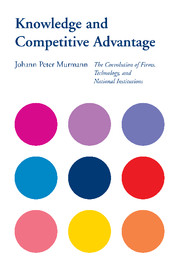Crossref Citations
This Book has been
cited by the following publications. This list is generated based on data provided by Crossref.
Sarasvathy, Saras D.
and
Dew, Nicholas
2004.
When Markets Are Grue.
SSRN Electronic Journal,
Täube, Florian A.
2004.
Proximities and Innovation: Evidence from the Indian IT Industry in Bangalore.
SSRN Electronic Journal,
Tushman, M.L.
2004.
From engineering management/R&D management, to the management of innovation, to exploiting and exploring over value nets: 50 years of research initiated by the IEEE-TEM.
IEEE Transactions on Engineering Management,
Vol. 51,
Issue. 4,
p.
409.
Tilly, Charles
2004.
Observations of Social Processes and Their Formal Representations.
Sociological Theory,
Vol. 22,
Issue. 4,
p.
595.
FORGUES, BERNARD
2004.
Comment on "Decoupling and the Cultures of Global Finance".
International Studies of Management & Organization,
Vol. 34,
Issue. 4,
p.
131.
Cabrera, Elizabeth F.
and
Cabrera, Angel
2005.
Fostering knowledge sharing through people management practices.
The International Journal of Human Resource Management,
Vol. 16,
Issue. 5,
p.
720.
Galambos, Louis
2005.
Recasting the Organizational Synthesis: Structure and Process in the Twentieth and Twenty-First Centuries.
Business History Review,
Vol. 79,
Issue. 1,
p.
1.
Lamberg, Juha-Antti
and
Laurila, Juha
2005.
Materializing the Societal Effect: Organizational Forms and Changing Patterns of Dominance in the Paper Industry.
Organization Studies,
Vol. 26,
Issue. 12,
p.
1809.
Chaharbaghi, Kazem
and
Jones, Colin
2005.
Firm transformation: advancing a Darwinian perspective.
Management Decision,
Vol. 43,
Issue. 1,
p.
13.
Jones, Colin
2005.
Contemplating Knudsen’s Baseline: Where Small is not so Beautiful.
Journal of Small Business & Entrepreneurship,
Vol. 18,
Issue. 3,
p.
273.
Witt, Ulrich
2005.
The Evolutionary Foundations of Economics.
p.
339.
Bünstorf, Guido
and
Murmann, Johann Peter
2005.
Ernst Abbe's Scientific Management: Theoretical Insights from a 19th Century Dynamic Capabilities Approach.
SSRN Electronic Journal,
Asakawa, Kazuhiro
and
Nakamura, Hiroshi
2005.
Iryo To Shakai,
Vol. 15,
Issue. 1,
p.
3.
Zellner, Christian
2005.
The Role of Labour Mobility and Informal Networks for Knowledge Transfer.
Vol. 6,
Issue. ,
p.
147.
Peltoniemi, M.J.
2005.
Co-evolution in an organization population of which knowledge-intensive service organizations form a part.
p.
880.
Mokyr, Joel
2005.
The Evolutionary Foundations of Economics.
p.
195.
Buenstorf, Guido
2006.
How useful is generalized Darwinism as a framework to study competition and industrial evolution?.
Journal of Evolutionary Economics,
Vol. 16,
Issue. 5,
p.
511.
Sheehan, Jerry
2006.
Understanding service sector innovation.
Communications of the ACM,
Vol. 49,
Issue. 7,
p.
42.
Boschma, Ron A.
and
Frenken, Koen
2006.
Why is economic geography not an evolutionary science? Towards an evolutionary economic geography.
Journal of Economic Geography,
Vol. 6,
Issue. 3,
p.
273.
Jones, Geoffrey
and
Khanna, Tarun
2006.
Bringing history (back) into international business.
Journal of International Business Studies,
Vol. 37,
Issue. 4,
p.
453.



